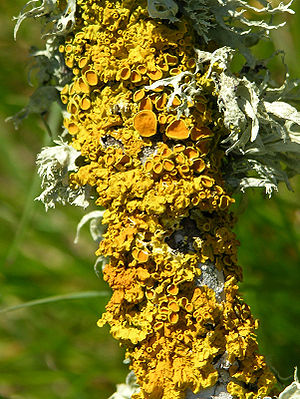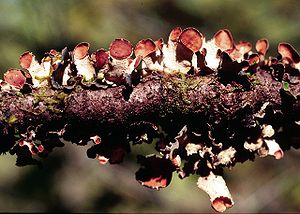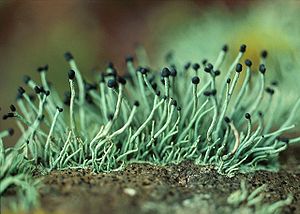Lichens: Difference between revisions
| Line 1: | Line 1: | ||
==Introduction== | ==Introduction== | ||
Lichens are a form of symbiotic association of fungi and algae. Lichens can also be formed by symbiotic association between fungi and cyanobacteria.The fungal partner in the lichen association is the "mycobiont", and cyanobacterial (or algal) partner is the "photobiont".They are unique organisms that can be found in different and contrasting environments. For example, lichens are found growing in Alaskan Tundra as well as in African Sahara desert.Lichens are morphologically diverse and found in different forms resembling even plants and fungal fruiting body. They grow at a very slow pace, a few millimeters a year and take a lot of time to establish on the substrate and based on the size of the lichens their age can be estimated. Lichen structures growing on forest trees and the lichens surviving on rocks can be very old, some times even million years old. For example, in recent years, researchers have identified lichen as old as 600 million years through analysis of fossil and phylogenetic data | Lichens are a form of symbiotic association of fungi and algae. Lichens can also be formed by symbiotic association between fungi and cyanobacteria.The fungal partner in the lichen association is the "mycobiont", and cyanobacterial (or algal) partner is the "photobiont".They are unique organisms that can be found in different and contrasting environments. For example, lichens are found growing in Alaskan Tundra as well as in African Sahara desert.Lichens are morphologically diverse and found in different forms resembling even plants and fungal fruiting body. They grow at a very slow pace, a few millimeters a year and take a lot of time to establish on the substrate and based on the size of the lichens their age can be estimated. Lichen structures growing on forest trees and the lichens surviving on rocks can be very old, some times even million years old. For example, in recent years, researchers have identified lichen as old as 600 million years through analysis of fossil and phylogenetic data <sup>[3]</sup>. Lichens play a significant ecological role as it can colonize barren earth and rock and make the harsh environment to a fertile one where other organisms can start establishing themselves <sup>[2]</sup>.In addition, some species of lichens inhabiting forests are important in providing food and shelter for birds and animals <sup>[4]</sup>. Further, lichens are being used as ecological indicators of pollution as they are very sensitive to changes in the environment. | ||
<ref name=dobson/> | <ref name=dobson/> | ||
Revision as of 03:07, 9 April 2010
Introduction
Lichens are a form of symbiotic association of fungi and algae. Lichens can also be formed by symbiotic association between fungi and cyanobacteria.The fungal partner in the lichen association is the "mycobiont", and cyanobacterial (or algal) partner is the "photobiont".They are unique organisms that can be found in different and contrasting environments. For example, lichens are found growing in Alaskan Tundra as well as in African Sahara desert.Lichens are morphologically diverse and found in different forms resembling even plants and fungal fruiting body. They grow at a very slow pace, a few millimeters a year and take a lot of time to establish on the substrate and based on the size of the lichens their age can be estimated. Lichen structures growing on forest trees and the lichens surviving on rocks can be very old, some times even million years old. For example, in recent years, researchers have identified lichen as old as 600 million years through analysis of fossil and phylogenetic data [3]. Lichens play a significant ecological role as it can colonize barren earth and rock and make the harsh environment to a fertile one where other organisms can start establishing themselves [2].In addition, some species of lichens inhabiting forests are important in providing food and shelter for birds and animals [4]. Further, lichens are being used as ecological indicators of pollution as they are very sensitive to changes in the environment.
Classification
Lichens are classified to three major groups based on their thallus structure. They are Crustose lichens,Foliose lichens and Fruticose lichens [6].
Crustose lichens
Crustose lichens grow holding tightly to their substarte, which may be rocks or trees. The color of crustose lichens can be green, orange, black or yellow. Crustose lichens are further divided in to [5],
Powdery or Leprose
Endolithic
Endophloeodic
Squamulose
Peltate
Pulvinate
lobate
Effigurate
Suffruticose
Foliose lichens
Foliose lichen is one of the important type of epiphytic lichens which appear like leaves. They grow on substrate loosly and easily dismantled without damaging the substrate on which it is growing. Foliose lichens form circular colonies and usually prefer trees and rocks to establish themselves [18].
Fruticose lichens
Fruticose lichens are 'shrubby' lichens which have plant like growth pattern and also can hang from the substrate.Fruticose lichens are round in cross section and and it is very difficult to distinguish the top and bottom of the lichen [19].
Diversity of the association
Ascomycetes and basidiomycetes are the main 'lichenized' fungal groups and majority of fungal partners (more than 95%) in lichen association belong to Ascomycetes [8]. Photobiont partners in the lichen association comes from 40 genera of cyanabacteria and algae when combined together [8].
Lichen symbiosis
Symbiotic association between the fungus and cyanobacteria(or algae) is a complex one. Fungal partner is responsible for the main structural framework of the lichen which is the 'thallus'.The photobiont stays inside the thallus and the mycobiont facilitates the gas exchange and light availability for the photobiont [6].Photobiont cells carry out photosynthesis and provide nutrients for fungus. The fungal partner in turn helps algae with improved water and nutrient uptake and also helps to survive under extremely unfavorable environmental conditions as a unit.
Lichen Nutrition
Most of the lichens do not have the mechanisms to absorb nutrients from soil and they depend on atmospheric sources for nutrition. Precipitation, fog ,dew and gaseous absorption plays an important role in atmosphric nutrition of lichens [10].Lichens growing on rock and soil surfaces are capable of entraping soulble nutrients form the respective sources [10]. Lichen has also been studied widely to address the relationship between the symbiosis and nutrient uptake.In a study, using nitrate as the nutrient source, researchers reported that at a critical level or less than the critical level of nitrate concentration, both photobiont and mycobiont shows similar rate of growth in Peltigera praetextata (Flk.) Vain [9].
Lichen reprodcution
Lichens undergo both sexual and asexual reproduction. Fragmentation is the most common method of lichen asexual reproduction.In fragmentation, a section of parent symbiont can develop in to a new lichen.Soredium and isidium are the two types of vegetative reproductive structures of lichens. Isidium grows out of the thallus and contains both photobiont and mycobiont cells covered by the cortical layer of thallus. Soredium is the other vegetative structure of lichens capable of 'independant growth'. Soredium also has photobiont cells wrapped mycobiont structures but, it is morphologically different from isidium. Isidium can be simple,branched cylindrical and scale like while soredium, most often has a powdery appearance.
Lichen's role in primary succession
Lichens play a major role in the primary sucession to develop a new community in a new habitat.They can initiate growth on rocks,volcanic rocks and glaciers and help to establish a diverse community in those habitats.Lichens growing on rocks (saxicolous lichens) can grow on top of rocks (epilithic) also inside the rock (endolithic)[4].They can cause both biophysical and biiochemical weathering effects to rocks [12].Lichens found on Hawaiian volcanic rocks have been reported to produce deep weathering crusts on basaltic lava [13].Lichen speices growing on Arctic alpine glaciers are used as indicators of glacial retreats to warn against global warming [13].
Lichen as pollution indicators
Lichens are very much sensitive to air pollution and has been used as an indicator of air pollution.Fruticose type is the most vulnerable lichen type and crustose type is the least vulnerable lichen type to air pollution, while foliose has intermediate vulnerability to air pollution [14].Generally some of the most susceptible lichen groups to air pollution are Ramalina, Lobaria and Usnea [16] . In a recent study, researchers indicated that lichen growth declined as a response to increase in sulphur dioxide and nitrogen content in the air [15].Presence of a lichen in abundance in an environment which usually does not grow well in that particular environment is regarded as one of the tools to assess the air pollution. For example, Lecanora conizaeoides has been found on trees in sulphur-compound-polluted parts of Sweden which is otherwise free of this lichen [17].
References
Erickson,W.N.,and Mann, R.(November 15,1947). Forest preserve district of Cook county (Illinois). Retrieved on April 08,2010 from [2].
Yuan, X., Xiao, S.,and Taylor T.N.(2005). Lichen-like symbiosis 600 million years ago.Science 308:1017-1020. Retrieved on April 08, 2010 from [3].
Forest Service Alaska Region,United States Dept. of Agriculture.(August,2006). Lichens of the national forest in Alaska. Retrieved on April 08, 2010 from [4].
Kawarabayasi et al. 2001. Complete Genome Sequence of an Aerobic Thermoacidophilic Crenarchaeon, Sulfolobus tokodaii strain 7. DNA Research 8:123-140.
Prangishvili D., K. Stedman, and W. Zillig. 2001. Viruses of the extremely thermophilic archaeon Sulfolobus. TRENDS in Microbiology 9 :39-43.
She et al. 2001. The complete genome of the crenarchaeon Sulfolobus solfataricus P2. PNAS 98:7835-7840.
Suzuki et al. 2002. Sulfolobus tokodaii sp. nov. (f. Sulfolobus sp. strain 7), a new member of the genus Sulfolobus isolated from Beppu Hot Springs, Japan. Extremophiles 6:39-44. Abstract
Edited by student of Angela Kent at the University of Illinois at Urbana-Champaign.
- ↑ Cite error: Invalid
<ref>tag; no text was provided for refs nameddobson




